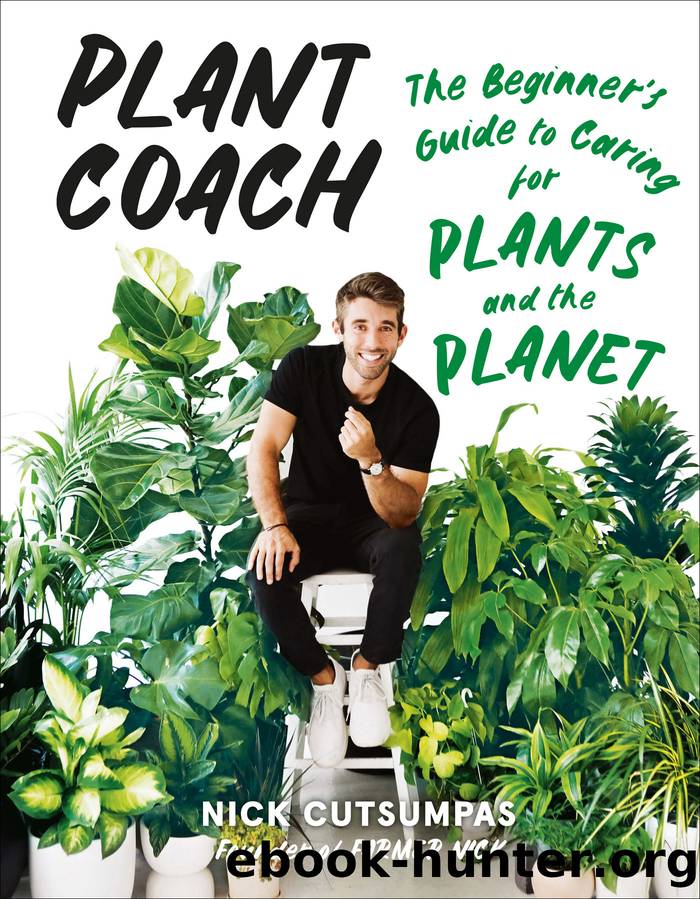Plant Coach: the Beginner's Guide to Caring for Plants and the Planet by Nick Cutsumpas

Author:Nick Cutsumpas
Language: eng
Format: epub
Publisher: Abrams
Published: 2022-10-18T00:00:00+00:00
1 Lay out your potting tarp outside or in a heated workspace if it is below 60 degrees Fahrenheit.
2 Disinfect your pot by scrubbing it with a solution of one part bleach and ten parts water. This is especially important for pots that have been used before and may be harboring diseases and pests.
3 For pots with drainage holes, place a small nursery pot over the hole or put a coffee filter over it.
4 Add a one- or two-inch layer of LECA (Lightweight Expanded Clay Aggregate) to the bottom of the pot. This is vital for pots without drainage holes because it creates a porous reservoir layer between the roots and excess water. Some people fear that this actually pushes the water up closer to the roots, but because the LECA is so porous, I havenât had any issues. Iâve also found that the roots will cling to the LECA to absorb more nutrients and water, making LECA a common amendment for passive hydro systems (plants growing without soil) or for propagation. I even add LECA to pots with drainage holes to increase the drainage even more.
5 Create your soil mix. Many seasoned plant people make their own custom soil blends, but you can start with a base that you like and then add amendments like coco coir, perlite, orchid bark, and horticultural charcoal as needed. I do my best to avoid peat moss because harvesting peat moss has a brutal impact on the environments where it is harvested.
6 Add a layer of soil on top of the LECA. The amount depends on the depth of the pot and where you want the plant to sit above the rim, but it should be at least two inches in pots more than six inches in diameter.
7 Remove the plant from the nursery pot, brush away excess soil, and begin teasing the roots. I remove no more than three quarters of the existing soil, and I cut away any dead or woody roots that are still visible. If Iâm potting up, I remove just one quarter of the loose soil and donât disturb the root ball much, if at all.
8 Position the plant at the bottom of the pot. Make sure that it is aligned properly and sits at least one inch below the rim of the pot. If it is positioned too high, you will not be able to cover the roots at the base of the plant and water will run off the sides. If trellising, add your trellis now so you donât have to jam it through the root system later.
9 Fill in the sides with your soil so the plant is supported on all sides. Really pack the soil and make sure there are no large pockets of air that will cause your plant to lean. If your soil mix is too compact, you can always aerate the soil later by poking it with your finger or a chopstick.
10 Give it a good water, make a few final adjustments to the positioning if necessary, and youâre ready to enjoy your plant.
Download
This site does not store any files on its server. We only index and link to content provided by other sites. Please contact the content providers to delete copyright contents if any and email us, we'll remove relevant links or contents immediately.
Turbulence by E. J. Noyes(7918)
The Thirst by Nesbo Jo(6804)
Gerald's Game by Stephen King(4552)
Be in a Treehouse by Pete Nelson(3919)
Marijuana Grower's Handbook by Ed Rosenthal(3605)
The Sprouting Book by Ann Wigmore(3529)
The Red Files by Lee Winter(3356)
The Remains of the Day by Kazuo Ishiguro(3278)
Sharp Objects: A Novel by Gillian Flynn(2936)
Christian (The Protectors Book 1) by L. Ann Marie(2643)
Organic Mushroom Farming and Mycoremediation by Tradd Cotter(2615)
The Culinary Herbal by Susan Belsinger(2418)
Stone Building by Kevin Gardner(2336)
The Starter Garden Handbook by Alice Mary Alvrez(2269)
Lilac Girls by Martha Hall Kelly(2242)
The Unlikely Pilgrimage of Harold Fry by Rachel Joyce(2201)
The Lean Farm Guide to Growing Vegetables: More In-Depth Lean Techniques for Efficient Organic Production by Ben Hartman(2081)
Urban Farming by Thomas Fox(2053)
Backyard Woodland by Josh VanBrakle(1879)
